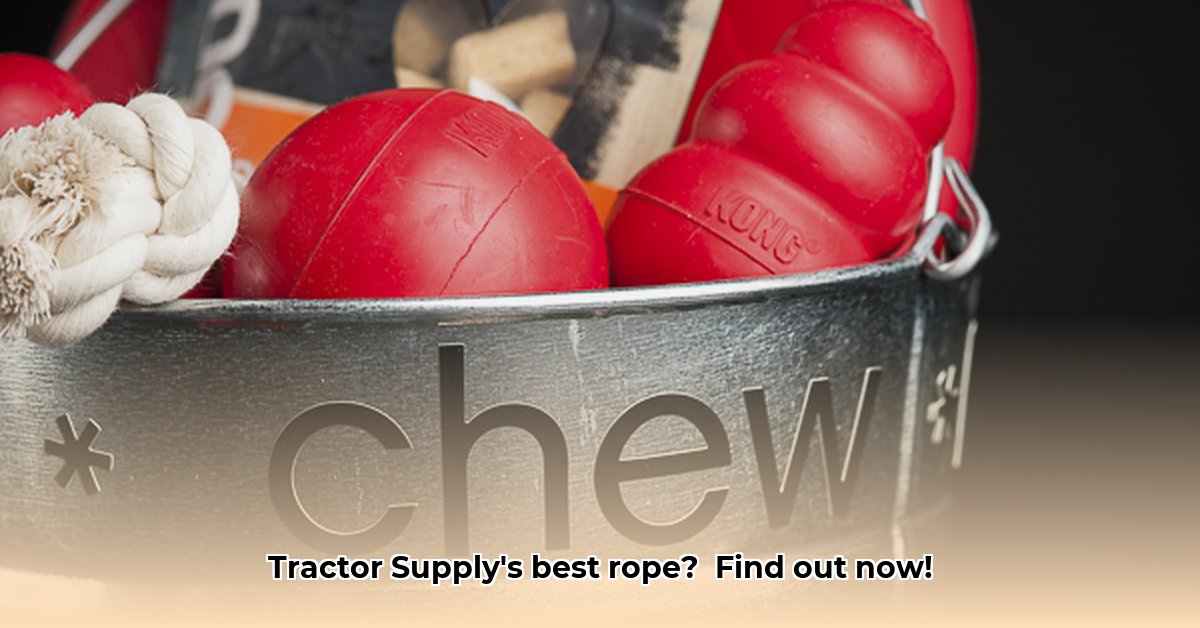
Choosing the Right Rope for Sustainable Agriculture
Selecting the right rope for your farm is crucial for both efficiency and environmental responsibility. Tractor Supply offers various options, each suitable for different tasks and aligned with sustainable farming practices. This guide will help you navigate your choices. Ignoring this crucial step could lead to crop failure or inefficient resource use—are you ready to optimize your farm's efficiency? For more rope options, check out Tractor Supply's selection.
Sisal Rope: A Biodegradable Choice
Sisal rope, a natural fiber rope made from the sisal plant, is a strong and completely biodegradable option. It's perfect for supporting climbing plants like tomatoes or beans, and for tying smaller hay bales. However, sisal is susceptible to moisture and will weaken and rot under wet conditions. Proper air circulation around your plants is essential when using sisal rope for support. Did you know that improperly stored sisal rope loses approximately 15% of its tensile strength within one month in humid conditions?
Polypropylene Rope: Durable and Long-lasting
Polypropylene rope, a synthetic option, is highly durable and water-resistant, making it ideal for securing heavy equipment, building fences, or working in wet conditions. Its longevity is a major advantage, but remember that it's not biodegradable, presenting a long-term environmental impact. While polypropylene’s strength is undeniable (a 1/2-inch diameter rope can often withstand loads exceeding 2000lbs), its non-biodegradability remains a crucial factor in your sustainable choices.
Manila Rope: A Balanced Option
Manila rope, made from abaca fibers, offers a balance between strength, flexibility, and biodegradability. Suitable for a range of tasks – haying, general farm chores, even lighter plant support – it's a good all-around option, lasting significantly longer than sisal in moist conditions but not as long as polypropylene. It’s a solid middle-ground option if your needs are diverse.
Here's a quick comparison table:
| Feature | Sisal Rope | Polypropylene Rope | Manila Rope |
|---|---|---|---|
| Strength | Medium | High | High |
| Water Resistance | Low | Very High | Medium |
| Biodegradability | High | Low | Medium |
| Cost | Moderate | Moderate to High | Moderate |
| Best Uses | Plant support, light haying | Heavy-duty tasks, fencing | General farm use, haying |
Working Safely with Rope: Essential Tips
Safety is paramount when handling rope. Following these steps will ensure your safety and the longevity of your equipment.
- Inspect Thoroughly: Always inspect your rope before each use. Discard any damaged rope immediately. A damaged rope can snap unexpectedly, causing injury.
- Master Knot-Tying: Practice basic knots like the square knot and bowline. Improper knotting drastically reduces the rope's strength.
- Respect Weight Limits: Never exceed the rope's weight limit. This information is printed on the packaging and should always be consulted.
- Protect Your Hands: Always wear gloves when working with rope to prevent abrasions and rope burns.
- Proper Storage: Store rope in a dry place away from direct sunlight and harsh chemicals to prolong its lifespan.
Sustainable Practices with Rope Selection
Choosing the right rope is a tangible step towards sustainable farming. Sisal’s biodegradability significantly reduces your environmental impact. However, even with natural fibers, responsible disposal is key. Composting sisal rope at the end of its life is generally possible, but polypropylene needs to be handled differently in line with local recycling guidelines. "Selecting a rope aligned with your farm’s values directly impacts your environmental footprint," states Dr. Emily Carter, Agricultural Sustainability Expert at Cornell University.
Calculating Sisal Rope Decomposition Rates
While precisely calculating sisal rope decomposition requires laboratory analysis, you can still make informed estimations on your farm.
- Controlled Experiments: Bury weighed sisal rope samples at different depths within various soil types on your farm.
- Regular Monitoring & Measurement: Regularly weigh the samples to track weight loss over time. Note the soil conditions (moisture, temperature, pH) at each site.
- Data Analysis & Interpretation: Record the weight loss to map the decomposition rate in different conditions. This helps understand how soil type impacts the lifespan of the rope.
By combining careful rope selection with conscious practices, you can optimize your farming operation for both efficiency and environmental responsibility. Remember, every decision, from the rope you choose to the methods you use, contributes to the health of your farm and the planet.